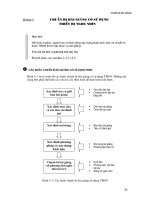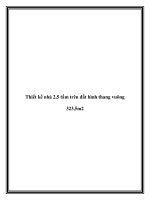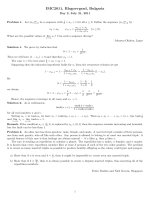Day 2 5 acidising summary
Bạn đang xem bản rút gọn của tài liệu. Xem và tải ngay bản đầy đủ của tài liệu tại đây (1.32 MB, 10 trang )
Day 1 summary
! Inflow vs Outflow
! Well stimulation: Fraccing and Matrix
stimulation
! Matrix stimulation
!
Sandstones: Only Damage Skin removed, S dam = 0
!
!
Chemistry complex
Carbonates: Damage bypassed, Sdam = ‐2
!
Chemistry relatively simple
! Sources of damage
1
What is the general purpose of
s5mula5on?!
! Making sure that the connection between
reservoir and well is not the bottleneck for
production
2
Which are the two main goals of well
s5mula5on?
! Removal of near well bore damage
! Increase of natural productivity
3
How are the two goals achieved?
5
Name three major sources of damage
! Chemical methods (Acid)
! Mechanical methods (Fracturing)
! Mud related damage
! Lost completion fluids
! clay problems; clay swelling, clay & fines
migration
6 What is the most appropriate treatment for None, no stimulation candidate
7
8
2 mD gas well with a skin of 1.5 and in
which losses occurred during comple5on?
An oil well with a high skin in a sandstone
forma5on containing streaks of up to 25%
calcite has been damage by mud losses.
What is the best type of acid to be used?
Which are the four main phases in
s5mula5on design?
Oct-19-15
HCl or organic, No HF!
• Candidate selection and damage analysis
• Fluids and additives recommendation
• Pumping schedule and flow (diversion) simulation
• Post‐job analysis
3
Classroom exercise
Name the 5 main items to
investigate whether a well is a
matrix stimulation candidate
Well performance – WIQI
Mechanical problems
Skin analysis
PLT
Damage assessment
A well is producing from a
sandstone reservoir of 20 mD with
40% oil saturation. Under which
conditions is this well in general a
stimulation candidate?
When it is producing less than 50%
water, not close to abandonment
and the tubing and production
facilities can handle extra
production.
A well has a total skin of 21 of
2 fold
which two thirds can be attributed
to formation damage. What is the
order of magnitude of production
improvement an acid treatment
could deliver?
Oct-19-15
4
Classroom exercise
What are the essential
differences between
carbonate and sandstone
acidising?
No HF
Damage by‐pass rather
than removal
Which factors control
wormhole formation
Surface Reaction Rate
Diffusion Rate
Injection Rate
Oct-19-15
5
What needs to be checked before a ! Cement quality
stimulation treatment can be
! Pressure limitations
executed on a well?
! Pumprates and fracturing
! Perforations
! Corrosion concerns
! Erosion concerns
Which are the perforation
! perforation diameter ‐ large
conditions favor a successful matrix ! shot density ‐ high
stimulation treatment?
! perforation phasing ‐ 120o or better
! perforation length – large
What are the corrosion protection ! Less than 0.05 lb/ft2 weight loss of
requirements for an acid treatment?
tubular steel
! No pitting
! In case of sour wells (H2S), no stress
corrosion cracking
! Always use corrosion inhibitors
! Use intensifiers if needed to meet above
criteria
How long should the well be shut‐
in after an acid treatment?
Oct-19-15
Best practice:
return spent acid to surface
immediately after the treatment
6
Name the most important mineral
components of a sandstone with
respect to acid treatments
Can HF/HCl mixtures be used in:
! High carbonate content
! Presence of wax
! Damage caused by clay particles
Describe the three spending stages in
sandstone acidising
Oct-19-15
Quartz
Feldspars
Clays
! Kaolinite
! Montmorillonite or smectite
! Illite
! Chlorite
Carbonates
Not if it is more than 10%
No, wax will not be removed by acid
Yes in most cases, but not in very high
temperatures or extremely water sensitive clays
Primary spending.
This is the damage removal step. Same as
classical theory.
Secondary spending.
Dissolved silicon will re‐precipitate as
Si(OH)4.
Tertiary spending.
Aluminum leaching, leaving Si(OH)4.
Potential Al scaling.
7
Will HCl be spent in clay rich
formations
Name the most common HF acid
systems
What are the normally used acid
volumes?
What is the typical treatment
procedure for an sandstone acid
treatment
Oct-19-15
Yes, but only during secondary and tertiary spending
! 13.5/1.5% HCl/HF
High HCl/HF ratio (prevent precip.)
! Retarded HF
For deep damage (fines migration)
! 9:1 HCl/HF
Low HF, for high feldspar formations
! Organic/HF
For higher temps
! 12/3 HCl/HF
‘Mud acid’ for silica scale removal
! HCl only
Whenever carbonate content > 10%
100 – 200 gals/ft
Mud Clean‐out (whole mud lost)
Wellbore Cleanout (pickle tubing)
Non‐acid preflush (NH4Cl) 50‐100 gal/ft
Acid Preflush (HCl)
50‐100 gal/ft
Damage Removal System (HF/HCl)
50‐200 gal/ft
Diverter stage
Overflush (NH4Cl) 25‐100 gal/ft
Displacement
8
What methods are available to obtain the kh in a
From a log, or combination of log and core tests
well?
From a well test (e.g. a buildup)
What alternative methods are available to obtain the Well test (build up or fall off).
skin in the well? Which method is the most
Analyse PI decline over time. Reservoir pressure and kh
reliable?
are also needed in this method.
Why is Water NOT a good choice as a Brine
Risk of clay swelling
Preflush?
Which of these two fluids (13.5% HCl/HF or 9/1%
HCl/HF) is preferred? Why?
13.5% HCl/HF preferred because it has a higher HF
concentration and is therefore more efficient.
What is the purpose of the Aqueous Non‐acid
Preflush (=Brine preflush)?
Establish injectivity before pumping acid, spacer
between acid and reservoir fluids.
What is the purpose of the Acid Preflush?
Remove carbonates, other (acid‐soluble) material,
incompatible with HF
What is the purpose of the Acid Mainflush?
Dissolve damage (clay fines)
In a sandstone acid treatment, what is the major
HF acid
difference in composition between the Acid Preflush
and the Acid Mainflush?
What is the purpose of the Non‐acid Overflush
(=Brine overflush)
Displace spent acid deeper into formation, to prevent
potential precipitations in near wellbore.
What brines are acceptable in HF acidizing?
Oct-19-15
Only NH4Cl (ammonium chloride)
9
When would you select coiled tubing to pump an
acid treatment? When bullheading? What are the
advantages/disadvantages of both methods?
What is the effect of pump rate on the final
treatment results? Is there a difference between
sandstones and carbonates?
The bottom hole pressure (BHTP curve) drops
rapidly, after the first brine stage (2% NH4Cl) has
reached the perforations. Why?
Coiled tubing: when tubing is dirty (rust, scale); in
longer wellbores (placement)
Bullheading: relatively short intervals, high rate
pumping
In sandstones the effect of pump rate is only small. The
main advantage of a higher pump rate is the shorter
treatment time.
In carbonate acidizing, pump rate is important. A higher
pump rate will result in longer wormholes and deeper
stimulation.
The viscosity of the injected brine is lower (about 0.4 cp,
see Pumping Schedule), compared to the viscosity of the
reservoir fluid (about 1.2 cp, see Reservoir Fluid Details
screen).
The BHTP goes down during the 13.5/1.5% HCl/HF The acid dissolves the damage, reducing the skin. As a
stage. Explain!
result, the bottomhole pressure decreases during the
treatment.
The skin drops from 10 to about 8, during the 7.5% The 7.5% HCl does not remove the fines damage, but it
HCl stage. Explain!
will dissolve the carbonate in the mineralogy. This
increases the permeability in the near wellbore, and
reduces the skin.
Why is lowering the HCl concentration a good idea? Cheaper, less corrosion and easier to inhibit.
Oct-19-15
10









